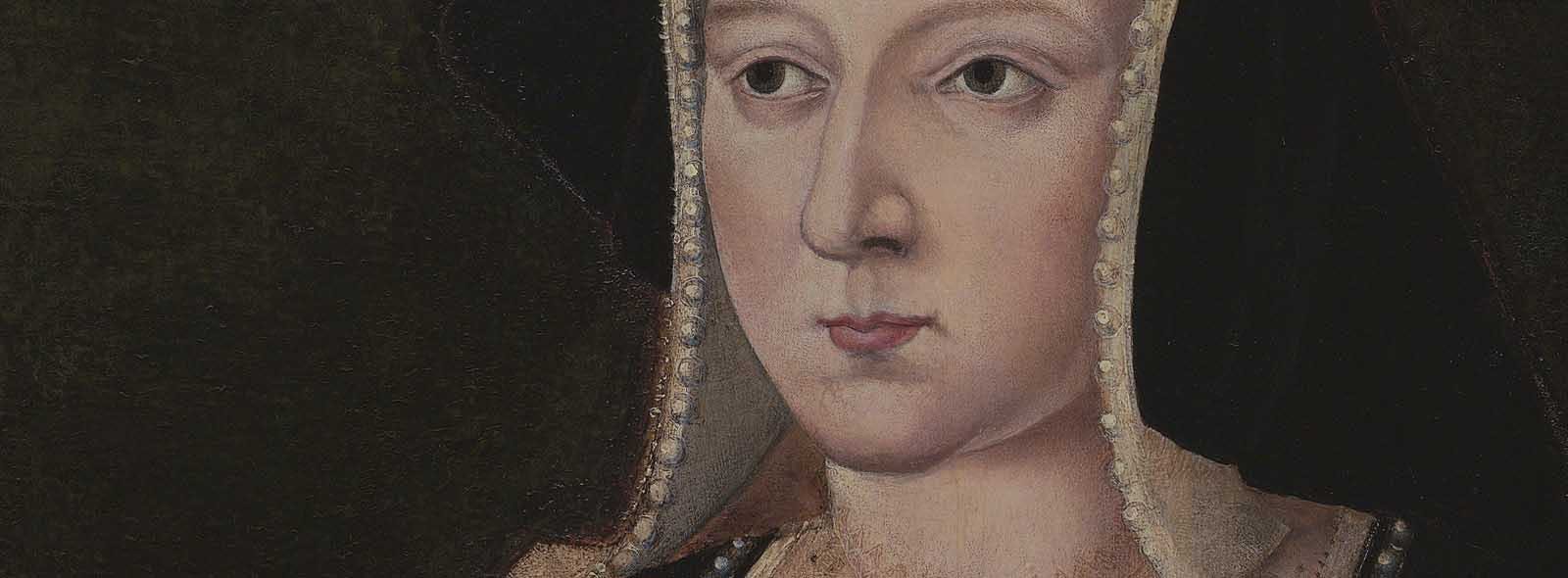
Henry VIII’s most devoted wife and queen?
Katherine of Aragon was the first wife of Henry VIII. In her eyes, she was his only queen.
Married to Henry for 24 years, Katherine was an intelligent, respected ruler who was devoted to her husband and her Catholic faith. As Queen, she acted as regent while Henry was away, and even oversaw an attempted invasion.
Yet she endured years of heartbreak. After becoming a teenage widow to Henry’s elder brother Arthur, Prince of Wales, Katherine bore the burden of Henry VIII's determination for a son and heir. Katherine gave birth to six children, but only a daughter (the future Mary I) survived. The King's obsession would split their marriage, and the country, in two.

Image: Portrait of Katherine of Aragon, early 1530s, Anglo-Flemish School, (16th century). © Philip Mould Ltd, London / Bridgeman
'Katherine' or 'Catherine'?
You may have seen Katherine’s name spelt many ways. Christened Catalina, she began writing her name as Katherine when she arrived in England in 1501. We have chosen to spell her name with a ‘K’ as this is how she usually signed letters and other documents as Princess of Wales, and then as Queen.
The Spanish Princess
Katherine of Aragon was born in Alcalá de Henares, near Madrid, on 16 December 1485. She was the youngest daughter of Queen Isabella of Castille and King Ferdinand of Aragon, whose marriage united the kingdom of Spain.
Though Katherine and her sisters were expected to forge marriage alliances with other European powers, Isabella was determined that her daughters be educated beyond traditional domestic skills. Katherine learned Latin and other modern languages by studying Catholic literature, and her intelligence brought respect from many contemporary scholars.
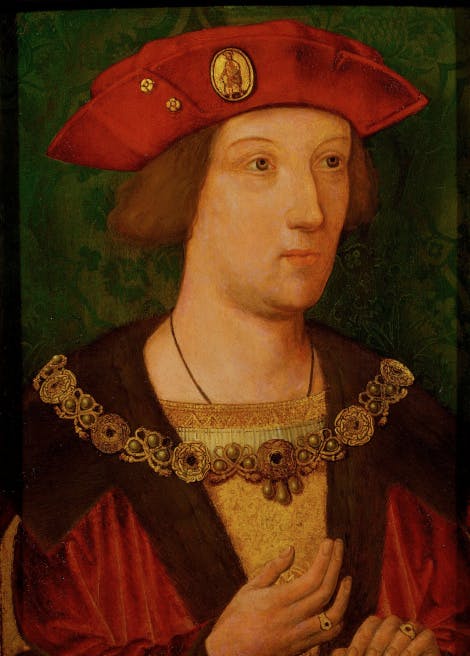
Image: Arthur, Prince of Wales. Royal Collection © His Majesty King Charles III 2024
A Royal Alliance: Katherine Marries Arthur, Prince of Wales
Katherine entered English politics as a child when her parents decided to negotiate an alliance with Henry VII, King of England, and his Queen, Elizabeth of York. She was betrothed to Prince Arthur, Henry’s eldest son, and left Spain in 1501, aged just 15. She travelled with her Spanish entourage, including two enslaved servants that possibly included Catalina of Motril.
Katherine and Arthur only met briefly before their wedding day. They were married at St Paul’s Cathedral on 14 November 1501, followed by a week of royal celebrations and tournaments. Among the guests was Arthur’s 10-year-old brother, Prince Henry.
Katherine settled quickly into her new role as an English Princess, wife, and future Queen. Accompanying Arthur on his duties as Prince of Wales, the couple left for Ludlow in December 1501. But tragedy struck.
Arthur died suddenly of a mysterious illness on 2 April 1502, leaving Katherine a teenage widow. They’d been married for less than five months.
Katherine's Uncertain Future
Despite Arthur’s tragic death, England and Spain still wanted to maintain their marriage alliance. They turned their attention towards the new heir to the English throne, Prince Henry as Katherine’s potential new husband.
Though Henry was technically her brother-in-law, Katherine and her attendants insisted that her marriage to Arthur was unconsummated, leaving them free to marry. Either way, the Pope granted permission for the match. All Katherine had to do was wait for the young Henry to come of age. But this was easier said than done.
Living far from home in a foreign country, Katherine relied on a limited allowance and later sporadic payments from the English royal family. Her father Ferdinand did not fully pay her dowry (payment from the bride’s family to the groom) to Arthur, meaning Katherine could not claim money from her former husband’s lands to support her household. The Princess wrote home to complain about poverty, isolation, and mistreatment.
Meanwhile, changing politics meant her betrothal to Prince Henry looked more uncertain. Katherine’s mother, Queen Isabella, died in 1504. Not only was this a personal tragedy for the young Princess, but a threat to peace in Spain. This uncertainty, combined with Katherine’s unpaid dowry, meant Henry VII started looking for other candidates to become his son’s future Queen.
Katherine grew frustrated. In 1507, she told her father that she and Prince Henry were being kept apart. By 1508, plans were made for Katherine to return to Spain. But fate had other ideas.
The New King Henry VIII
Henry VII died on 21 April 1509, leaving his 17-year-old son to inherit the throne as King Henry VIII. Within days of his father’s death, Henry chose 24-year-old Katherine of Aragon as his Queen.
Why? Some accounts claim it was his father's dying wish; despite the old King’s reservations, a Spanish alliance with Katherine’s powerful and well-connected family was still an attractive prospect. But other historians believe that the new King was in love with the strong-willed and intelligent Princess.
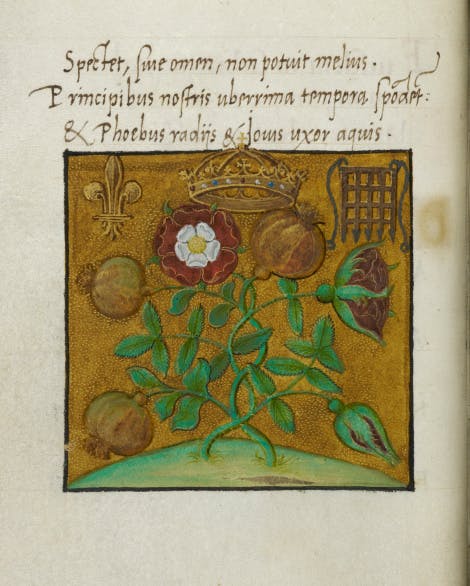
Image: Poems on the coronation of King Henry VIII of England and Queen Katherine of Aragon, by Sir Thomas More. Courtesy British Library, Cotton Titus D. IV f.12v
Marriage and Coronation
Katherine and Henry were married at Greenwich on 11 June 1509. A few weeks later, the couple stayed the night at the Tower of London before parading in splendour to their joint coronation celebrations at Westminster.
Katherine travelled in a horse-drawn litter wearing an embroidered white dress, her long hair loose down her back. Presented with a golden crown and sceptre, she was finally Queen of England.
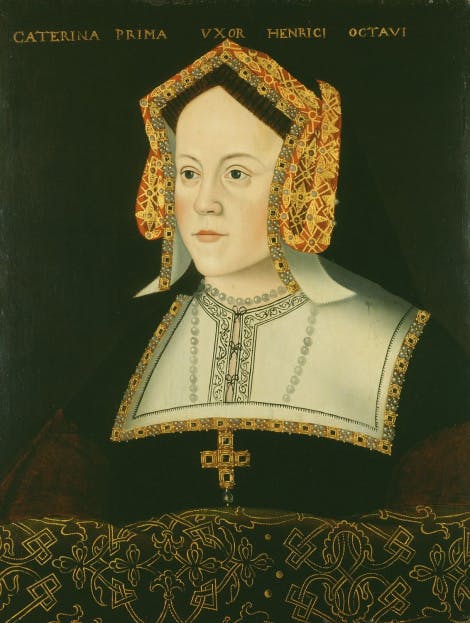
Image: Katherine of Aragon. Royal Collection © His Majesty King Charles III 2024.
Katherine as Queen, Regent and Diplomat
Henry and Katherine were devoted to each other for many years and as Queen, Katherine emerged as a popular and respected Queen Consort.
In fact, Henry trusted Katherine to act as regent while he was fighting in France. In 1513, she oversaw a national crisis when James IV of Scotland tried to invade England, even leaving the safety of London to ride north with over 1,500 sets of armour for her troops. After James’ defeat at the Battle of Flodden, Katherine sent her husband the Scottish King’s bloodied cloak. She wanted to send James’ body too, but remarked that, 'our Englishmen’s hearts would not suffer it'.
Not only a victorious regent, Katherine was also a skilled diplomat. In 1507, while still waiting for Henry to come of age, Katherine’s father appointed her as his ambassador to England, writing coded letters and negotiating with Henry VII. As Queen, Katherine excelled as an expert hostess. One of her finest hours was in 1520 when she entertained King Francis I in the English camp during the Field of the Cloth of Gold.
Katherine valued education throughout her life and was well known as a patron of religious literature. She supported institutions such as Queen’s College Cambridge and was admired by respected scholars such as Sir Thomas More and Erasmus of Rotterdam. Katherine was also a good friend and patron of Juan Luis Vives, a noted scholar who promoted women’s education. Vives later wrote a treatise to guide the education of Katherine’s daughter, Princess Mary.
Katherine earned and enjoyed the popular support of her adopted country. As Queen of England for over two decades, she drew praise for her intelligence, her generous charity and as a model of Christian womanhood.
The queen is well instructed – not merely in comparison with her own sex and is no less to be respected for her piety than her erudition.
Erasmus, Dutch Humanist Scholar about Katherine of Aragon

Image: Pomegranates in the Rose Garden at Hampton Court Palace. © Historic Royal Palaces
Katherine at Hampton Court Palace
Katherine often stayed at Hampton Court Palace as the guest of Cardinal Thomas Wolsey, Henry's chief advisor. She also stayed there after Henry acquired the palace in 1527.
You can still find remnants of Katherine at Hampton Court to this day. In the Great Hall, Katherine's personal emblem – the pomegranate – can be found carved onto a doorway. Fittingly, you might also find pomegranates growing in the Rose Garden overlooking the Tudor palace.
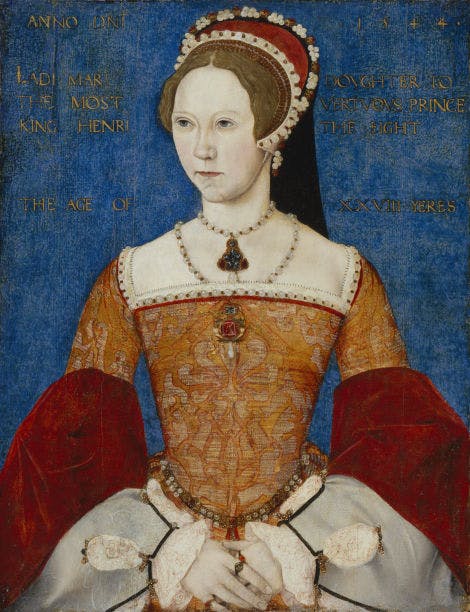
Image: Queen Mary I, the daughter of Katherine of Aragon and Henry VIII. © National Portrait Gallery, London
Henry's Pursuit of an Heir
As Queen, Katherine was expected to provide Henry with male heirs. We don’t know how many times Katherine became pregnant, but between 1510 and 1518 she suffered multiple stillbirths and miscarriages.
She did give birth to a son, Prince Henry Duke of Cornwall, in 1511; the christening celebrations included a lavish tournament at Westminster. But tragedy struck. The baby died at just 52 days old, leaving the royal couple devastated.
In 1516, Katherine gave birth to Princess Mary (the future Mary I) who was her only child to survive to adulthood. Katherine adored her daughter and she saw to Mary's education as her mother did for her. Yet Henry was still anxious for a boy.
After years of grief, the Queen endured her last pregnancy in 1518. The child, a daughter, did not survive.
We are both young; if it was a daughter this time, by the Grace of God the sons will follow.
Henry VIII to the Venetian Ambassador after Mary's birth, 1516
Read more: Henry VIII's children
Enter Anne Boleyn
In 1522, Anne Boleyn arrived at court as one of Katherine’s ladies-in-waiting. Recently returned from the fashionable French court, Anne was young, elegant, and witty. Henry became obsessed with her.
Henry was known to have other lovers during his marriage to Katherine. He had an illegitimate son with Lady Elizabeth (Bessie) Blount in 1519 and became involved with Anne’s sister Mary until 1525. Like many queens, Katherine endured the King’s mistresses in silence.
But Anne was not just another mistress. She refused the King’s advances, either for her virtue or in pursuit of her own or her family’s ambitions. Instead, she held out for the possibility of marriage.
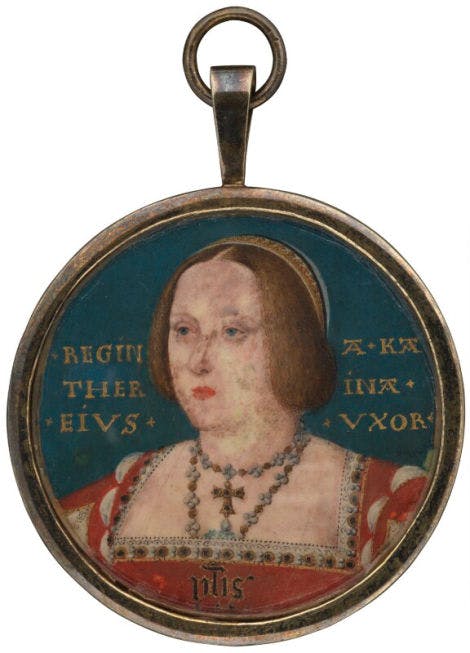
Image: Katherine of Aragon c.1525, attributed to Lucas Horenbout. © National Portrait Gallery, London
Henry Attempts to Divorce Katherine
But even the King could not do what he liked. To marry Anne Boleyn, Henry would first need to end his marriage to Katherine. But this would not be easy; divorce was very rare in Tudor England, and formally separated couples were not allowed to marry again.
What Henry needed was a statement from the Pope that confirmed his marriage to Katherine was invalid – known as an annulment. This way, the King would not only be rid of Katherine, but any children he had by Anne would be legitimate heirs to the throne.
Henry’s case for an annulment focused on Katherine’s marriage to Arthur and whether she had 'consummated' their relationship – meaning, whether she had ever had sexual intercourse with her first husband. If so, Henry could argue that he had married his ‘sister’ and committed the sin of incest. This would make his marriage to Katherine illegitimate, even if the Catholic Church had allowed the match to go ahead.
Determined to have his way, Henry dispatched Cardinal Wolsey to appeal to the Pope and solve what became known as the King's 'great matter'.
Katherine Strikes Back
But Katherine of Aragon would not go quietly. She believed being Queen of England was her divine duty, and she had made a promise before God to be Henry’s wife. She also wanted to protect her daughter Mary from being declared illegitimate.
As Henry later admitted, Katherine was a ‘proud and intractable woman’ who would ‘carry on war against him’ for her only child.
Katherine had powerful allies and a stubborn will. She appealed to her nephew, Holy Roman Emperor Charles V, to defend her case to the church and, in 1529, she appeared in court at Blackfriars in front of Henry VIII and two Cardinals, including Thomas Wolsey.
Falling to her knees, Katherine swore publicly that she had never consummated her marriage to Arthur and that 'this twenty years I have been your true wife'.
After years of investigation, including seeking out Katherine’s former servant, Catalina of Motril, the Pope refused to grant Henry’s annulment. The Queen had won this battle, but the King would not accept defeat.
Henry Breaks with Rome
Since he could not get his own way through the Pope, Henry did the unthinkable. Inspired by the Reformation, a movement that challenged the authority of the Catholic Church, he broke ties with Rome and the Pope.
The King declared himself the Supreme Head of the Church of England, which would allow him to decide England’s religious future – including rules about divorce and annulment.

Image: A portrait drawing of Princess Mary, 1537-43, featured in the Holbein at the Tudor Court exhibition. Royal Collection Trust © His Majesty King Charles III 2024
Katherine in Exile
Katherine saw Henry for the last time in July 1531. The King sent her away from court and cruelly forbid her from taking Princess Mary. She would never see her daughter again.
Between 1531 and 1536, Katherine was moved from house to house and gradually stripped of her friends and servants. As Queen for over 20 years, Katherine still attracted significant popular support and Henry wanted to isolate her from potential allies.
On 23 May 1533, Archbishop Thomas Cranmer finally annulled Katherine's marriage to Henry VIII. The King had already married the pregnant Anne Boleyn the previous January and had her crowned publicly in June.
But Katherine would not bend. She refused to accept Henry's new church, new wife, or her new title of 'Princess Dowager'. In her eyes, she was still Queen of England.
For my part, I pardon you everything. I make this vow, that mine eyes desire you above all things.
Katherine's last letter to Henry, signed 'Katherine, the Queen'

Image: Katherine of Aragon's Will, 1536. Courtesy British Library, Cotton Otho C. X, f.217
The Death of Katherine of Aragon
In May 1534, Katherine moved to Kimbolton Castle, where she continued writing letters to her allies and expressing concern for Princess Mary. Her health was deteriorating, but Henry still forbade Mary from visiting her mother. Her Spanish allies begged the King to let them see her. While some secured permission, others went to the castle behind his back.
Katherine of Aragon died on 7 January 1536, aged just 50 years old. Reports suggest Henry and Anne were relieved, and rumours flew around Europe that the former Queen had been poisoned. However, she probably suffered from cancer. Katherine is buried at Peterborough Cathedral.
Queen Katherine's Legacy
Some historians have cast Katherine of Aragon as a tragic figure. She is remembered as the wronged wife who was set aside for another woman. But Katherine was Queen of England for over 20 years. More than the heartbreak of her final days, she was a respected consort, devout Catholic and loving mother.
Katherine's story has been retold many times in popular culture. While some portrayals such as The Tudors centre on the drama of her and Henry's 'divorce', more recent adaptations have sought to reveal more of the woman herself, such as Six: The Musical and The Spanish Princess.
Katherine of Aragon could have quietly accepted her fate, but her stubborn defiance meant she fought till the bitter end. Her iron will forced Henry VIII to defy the Pope in Rome and would change the course of English history forever.
Listen to the podcast
The Six Tudor Queens: Katherine of Aragon
Tracy Borman opens our new series on the Queens Consort of Henry VIII with renowned historian Dr Elizabeth Norton. To better understand the six queens, they first explore the context of the turbulent times in which these women lived.
As the first Queen of Henry VIII, Katherine of Aragon’s reputation as the dowdy wronged wife has endured for 500 years, but Tracy and Elizabeth call this into question. They reveal that Katherine’s iron-will was both her strength and arguably her undoing.
Please be aware that this episode contains references to miscarriages, still births and infant mortality.
More episodesPodcast Transcript
Browse more history and stories

Henry VIII’s wives: six queens, six women
These six queens consort all had one man in common. But is it possible to understand them as individuals, even after 500 years?
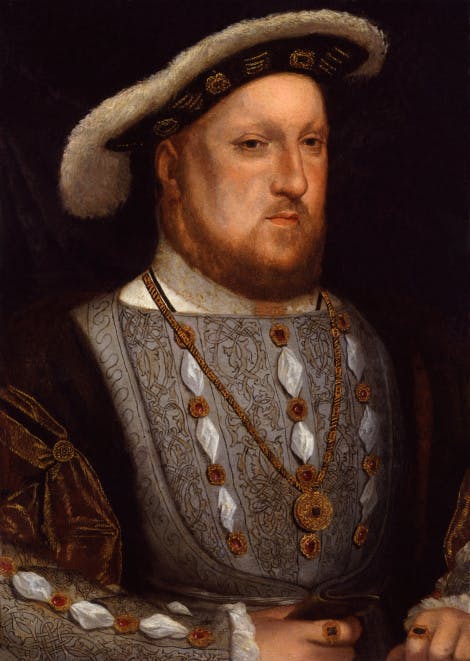
Henry VIII, Terrible Tudor?
Who was the real Henry VIII?

Henry VIII's children
All three ruled England
Explore what's on

- Families
- Half term
- Things to see
February Half Term
Join a royal quest this half term with Elizabeth I at Hampton Court Palace.
-
14 – 22 February 2026
- 10:00-16:00
- Hampton Court Palace
- Included in palace admission (Members go free)
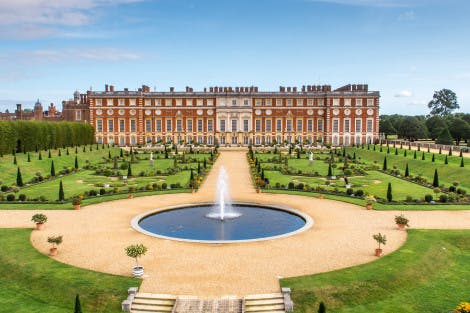
- Things to see
Hampton Court Gardens
Take time to explore and relax in these world-renowned gardens and find our free entry Garden Open Days dates.
- Open
- In line with palace opening hours
- Hampton Court Palace
- Included in palace admission (Members go free)

- Things to see
Pond Gardens
Discover the sunken gardens created for Henry VIII and transformed by Mary II.
-
Open
- In line with palace opening hours
- Hampton Court Palace
- Included in palace admission (Members go free)
Shop online

Christmas homepage banner - Henry VIII and Six Queens Decoration Set
Christmas Homepage Banner - Henry VIII and Six Queens hanging decoration set on a Christmas tree at Hampton Court Palace.
£70.00

Shop Tudors
Find the perfect gift for collectors and history enthusiasts in our treasure trove of souvenirs inspired by this ever-fascinating dynasty.
From £3.00

Shop Goblets & Tankards
Discover our decadent range of goblets and tankards inspired by the palaces in our care, the perfect gift for any history fan.
From £10.00
